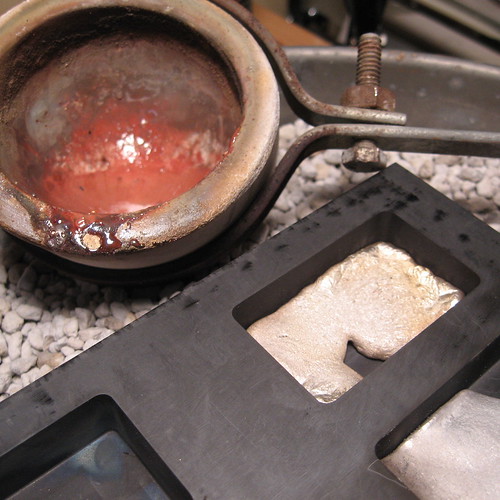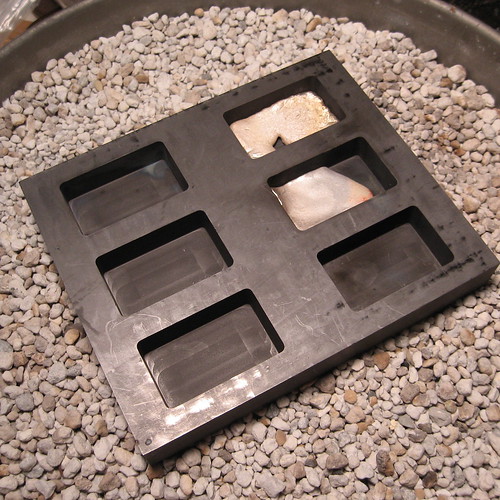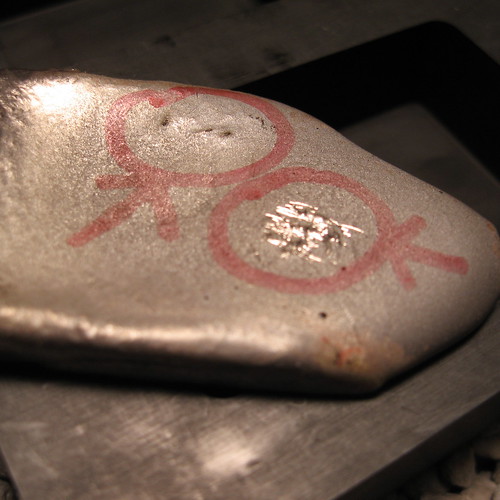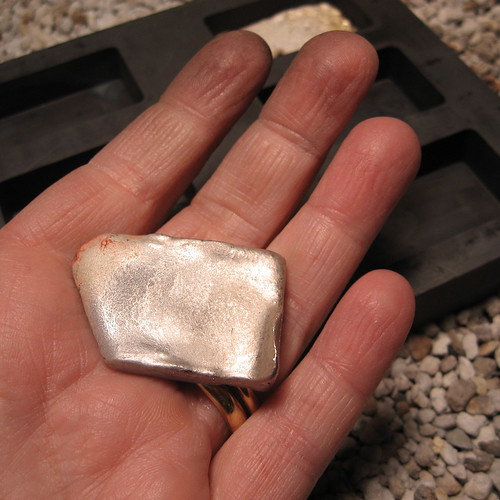I have mounds, tubs, and drawers full of silver scraps in all shapes and forms. Dust, filings, spirals, corners, wire, failed projects..... I want to reuse my scrap and make fresh stock from it.
I just got this nifty graphite ingot mold. Each compartment will hold 5 ounces (or was it 10?) of silver. So after a few trial runs and many more needed, I produced one somewhat useable ingot. I think I need more practice. And oxygen for my torch.
Here's what I learned:
1. Make sure the mold is ripping hot before you pour. As soon as the molten silver hits cold graphite , it shrieks and promptly cools. Ok, it doesn't shriek, but imagine what you would do if you jumped into the north Atlantic Ocean in February. See? Shriek. If not poured into a hot mold, the ingot in question will not be lovely and solid, but a disastrous mess of folds, pits, and air bubbles. I should have known this. I've poured into iron molds many a time and I always, always, always get the mold smoking hot right before I pour (and it is really smoking 'cause the oil on the irons surface begins to burn away.... and the oil is there to keep the molten metal from sticking to the mold).
2. Make darn sure that there are not any foreign objects in your scrap before you melt. When I say foreign, I mostly mean steel or iron. Check out the image above. I circled what appears to be a chain popping out of the surface. I actually saw the chain floating around in the molten silver and honestly tried to fish it out with a pick. I'll have to melt this down and try again.
3. Be set up (that is, have enough scrap on hand) to pour more than once. Nothing gets a mold nice and hot than a fresh pour. Use this to your advantage.
4. Weigh out your metal as to have enough to pour a decent sized ingot. I did not do this. The image above shows a so-so pour. If I had more metal rolling around in the crucible, the ingot would have filled nicely to the sides of the mold.
5. Lastly, make sure that your studio is properly exhausted or get a big fan going and open a window. And be warned, your smoke detector will go off. And warn your family that the detector just may go off. Warn them especially if they are all in bed because it's an ugly scene otherwise.
Happy pouring!
Subscribe to:
Post Comments (Atom)












My apologies to anyone who had to struggle through all the typos first time around. That silly auto-correct. Gave me a good laugh though :)
ReplyDeleteThis is like magic. And it seems really complicated! How fun!
ReplyDeleteAnd it is magic and a completely labor of love. Economically it doesn't make the most sense, but ecologically it makes perfect sense.
DeleteHello Quench :) i think you need a smaller mold. This one is too much big. And you can try adding to the mold metal a little pinch of what we call in Italy "borace" (here very easy to find). (Na2B4O5(OH)4·8(H2O))
ReplyDeleteIs what we use for to make a weld
It have the ability to stick together all the trash what can be inside the metal and made it cleaner
(sorry for my english very poor) :)
ciao!
Never have tried to melt down my scrap metal. So, I am intreiged with your blog, today. I didn't even no how to begin, if I was going to venture into this . Once you have this silver ingot , how will you incorporate it into jewelry ? I really am very interested in this process.
ReplyDeleteSo, what ultimately will happen is this: I'll pound the heck out of the ingot to compress the molecules (hammering in the same direction). Then I'll anneal and roll the ingot through the rolling mill many times. repeat process. Along the way, I'll have to file the edges or the upper and lower edge will flare out and will eventually fold in on each other if not remove. The end result would be nice sterling sheet in any gauge you desire.
DeleteHi Penelope, yes, Borax. I used this. I don't think that it would take steel out of molten silver. At least it didn't help this time around. And yes, a smaller mold would help as well. Thanks for the advice!!!
ReplyDeleteThanks for this interesting post - I've never seen flat/open molds like that before. If I had one of those I might actually get all of the metal into the mold!!!
ReplyDelete